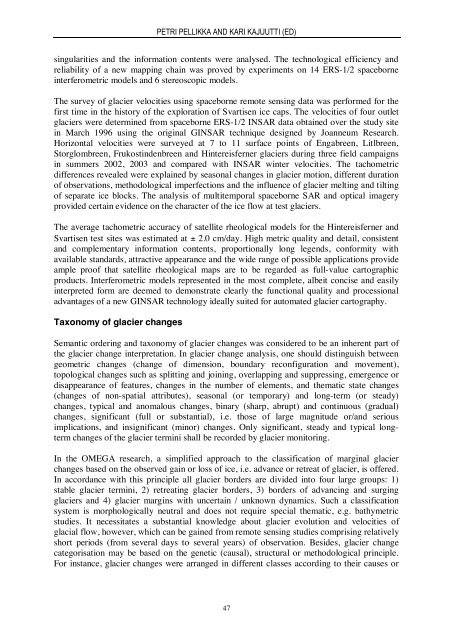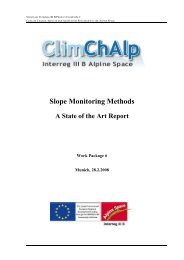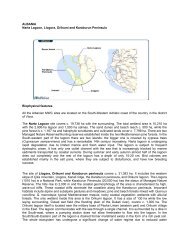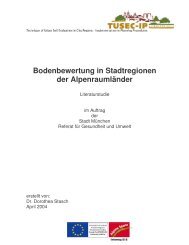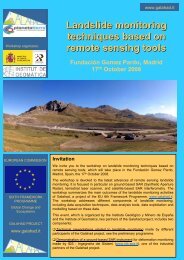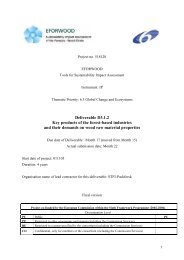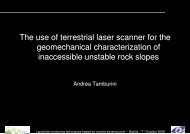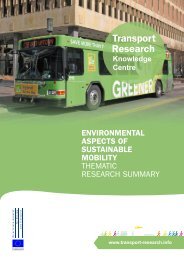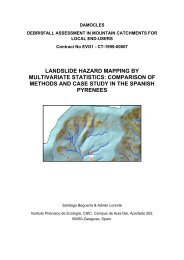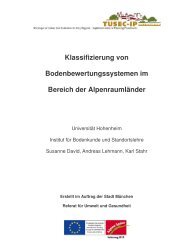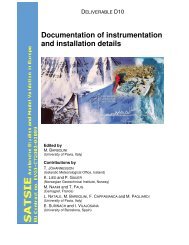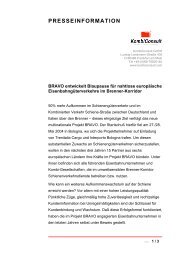1 Background - mountain.PROJECTS
1 Background - mountain.PROJECTS
1 Background - mountain.PROJECTS
You also want an ePaper? Increase the reach of your titles
YUMPU automatically turns print PDFs into web optimized ePapers that Google loves.
PETRI PELLIKKA AND KARI KAJUUTTI (ED)singularities and the information contents were analysed. The technological efficiency andreliability of a new mapping chain was proved by experiments on 14 ERS-1/2 spaceborneinterferometric models and 6 stereoscopic models.The survey of glacier velocities using spaceborne remote sensing data was performed for thefirst time in the history of the exploration of Svartisen ice caps. The velocities of four outletglaciers were determined from spaceborne ERS-1/2 INSAR data obtained over the study sitein March 1996 using the original GINSAR technique designed by Joanneum Research.Horizontal velocities were surveyed at 7 to 11 surface points of Engabreen, Litlbreen,Storglombreen, Frukostindenbreen and Hintereisferner glaciers during three field campaignsin summers 2002, 2003 and compared with INSAR winter velocities. The tachometricdifferences revealed were explained by seasonal changes in glacier motion, different durationof observations, methodological imperfections and the influence of glacier melting and tiltingof separate ice blocks. The analysis of multitemporal spaceborne SAR and optical imageryprovided certain evidence on the character of the ice flow at test glaciers.The average tachometric accuracy of satellite rheological models for the Hintereisferner andSvartisen test sites was estimated at ± 2.0 cm/day. High metric quality and detail, consistentand complementary information contents, proportionally long legends, conformity withavailable standards, attractive appearance and the wide range of possible applications provideample proof that satellite rheological maps are to be regarded as full-value cartographicproducts. Interferometric models represented in the most complete, albeit concise and easilyinterpreted form are deemed to demonstrate clearly the functional quality and processionaladvantages of a new GINSAR technology ideally suited for automated glacier cartography.Taxonomy of glacier changesSemantic ordering and taxonomy of glacier changes was considered to be an inherent part ofthe glacier change interpretation. In glacier change analysis, one should distinguish betweengeometric changes (change of dimension, boundary reconfiguration and movement),topological changes such as splitting and joining, overlapping and suppressing, emergence ordisappearance of features, changes in the number of elements, and thematic state changes(changes of non-spatial attributes), seasonal (or temporary) and long-term (or steady)changes, typical and anomalous changes, binary (sharp, abrupt) and continuous (gradual)changes, significant (full or substantial), i.e. those of large magnitude or/and seriousimplications, and insignificant (minor) changes. Only significant, steady and typical longtermchanges of the glacier termini shall be recorded by glacier monitoring.In the OMEGA research, a simplified approach to the classification of marginal glacierchanges based on the observed gain or loss of ice, i.e. advance or retreat of glacier, is offered.In accordance with this principle all glacier borders are divided into four large groups: 1)stable glacier termini, 2) retreating glacier borders, 3) borders of advancing and surgingglaciers and 4) glacier margins with uncertain / unknown dynamics. Such a classificationsystem is morphologically neutral and does not require special thematic, e.g. bathymetricstudies. It necessitates a substantial knowledge about glacier evolution and velocities ofglacial flow, however, which can be gained from remote sensing studies comprising relativelyshort periods (from several days to several years) of observation. Besides, glacier changecategorisation may be based on the genetic (causal), structural or methodological principle.For instance, glacier changes were arranged in different classes according to their causes or47


